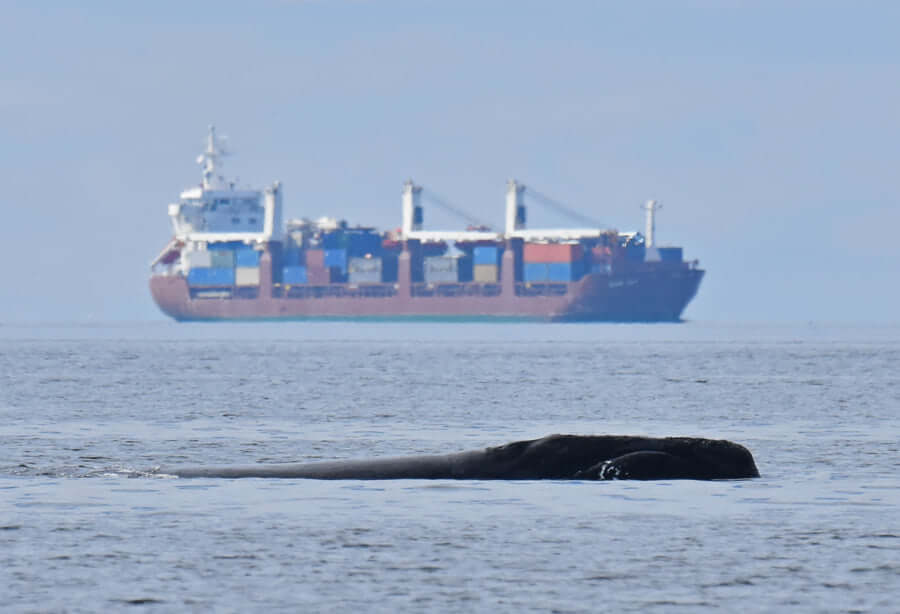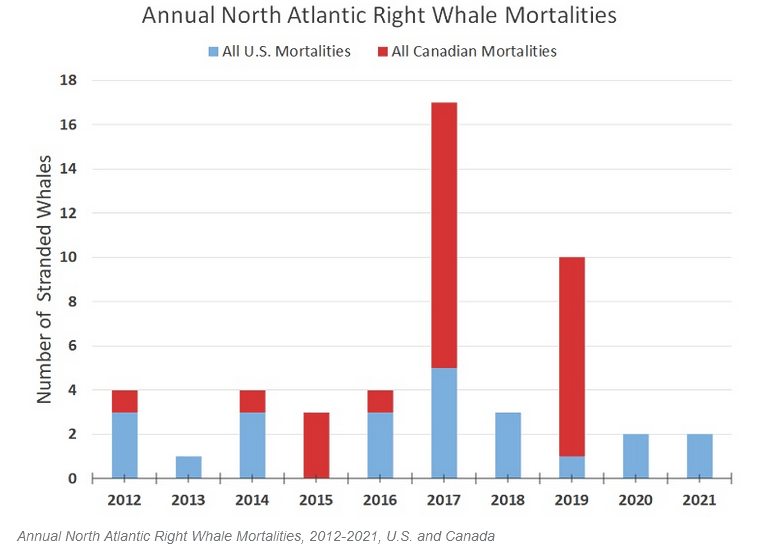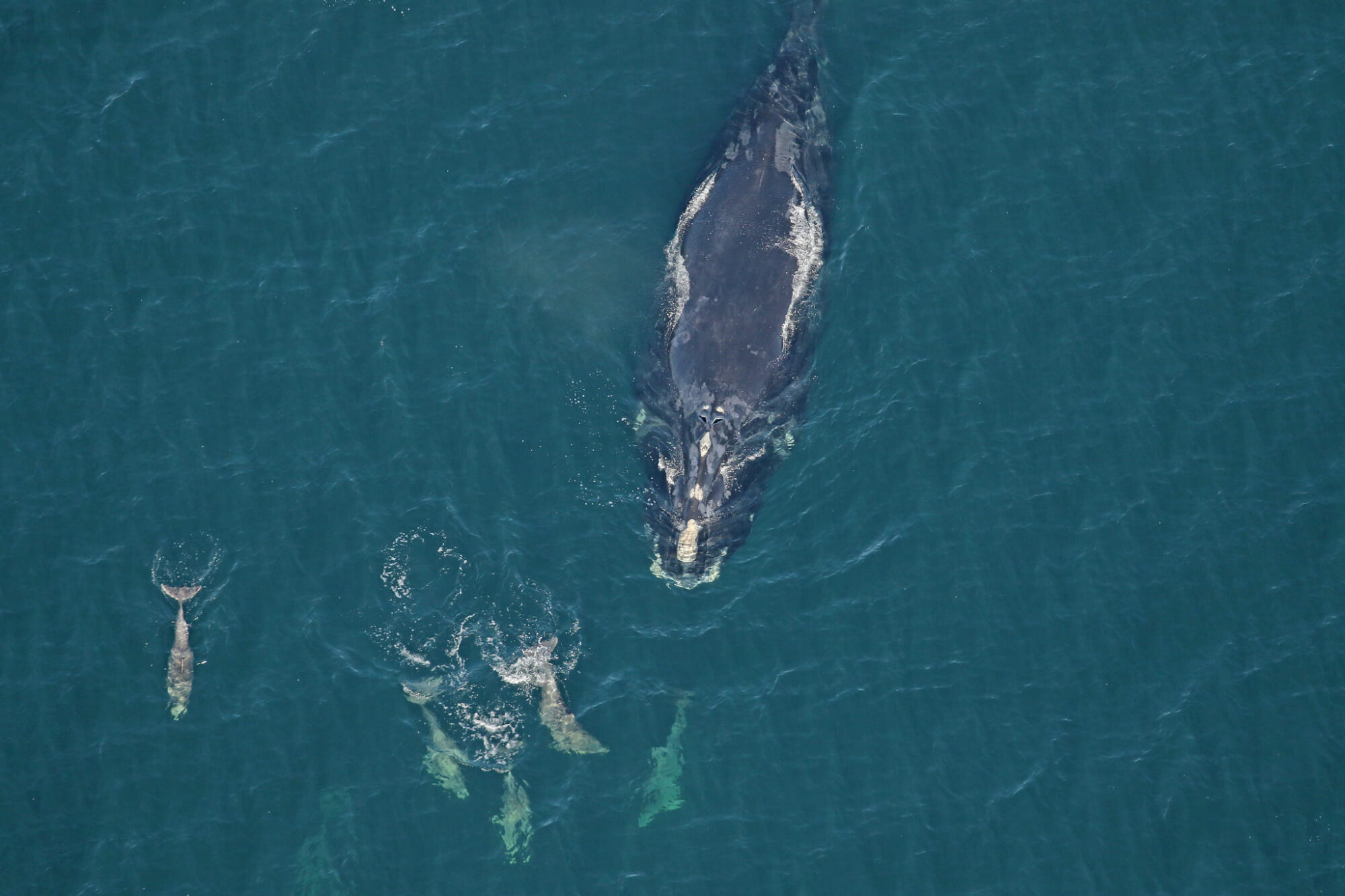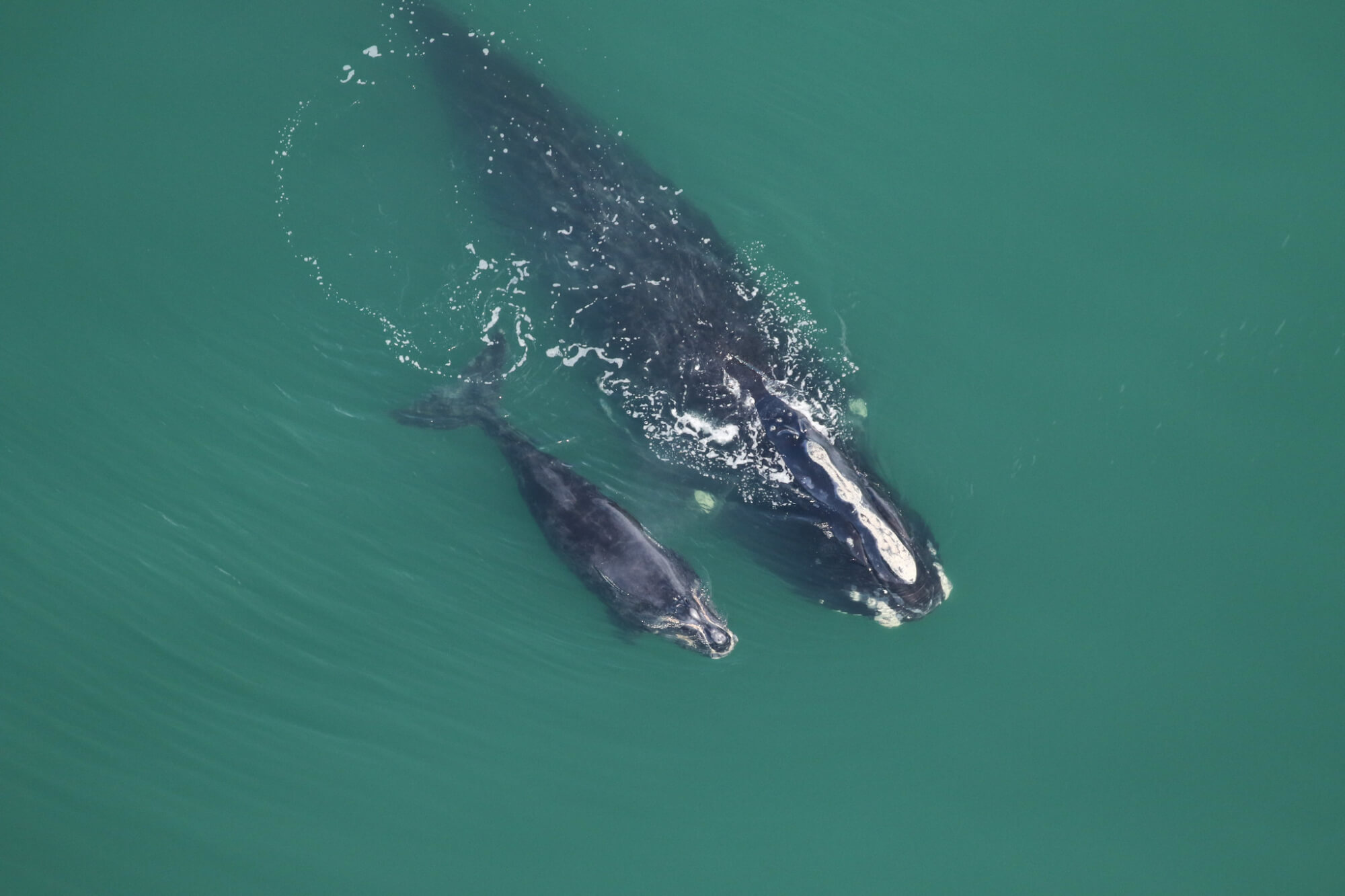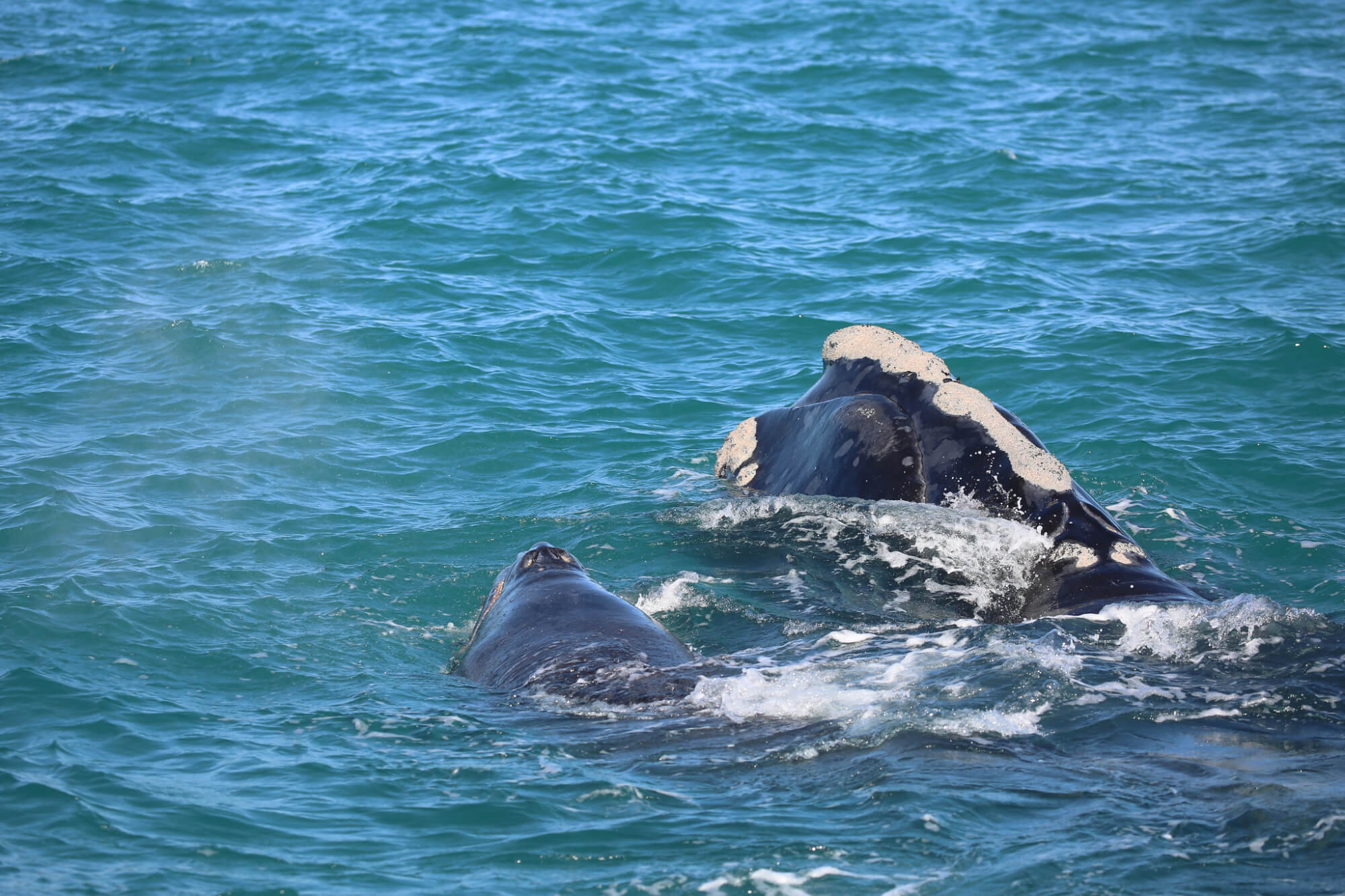With a total population estimated to number fewer than 350 individuals, the North Atlantic right whale is one of the most endangered cetaceans in the world. Its survival hangs by a thread, and the fate of the species depends on our ability to share the oceans with these giants.
[Learn more about the North Atlantic right whale.]
Plump and quite slow, right whales – also known as northern right whales or black right whales – have been heavily hunted for centuries and driven to the brink of extinction. Today, the North Atlantic right whale, which lives primarily along the east coast of the United States and Canada, faces new dangers: entanglements in fishing gear and collisions with ships. In recent years, climate change appears to be altering the habits of the right whale’s prey, resulting in shifts in the cetacean’s migratory patterns. While right whales historically spent the summer in the Bay of Fundy, they have been increasingly venturing into the Gulf of St. Lawrence, where they face new dangers.
Since 2017, 34 carcasses have been found in US and Canadian waters, an exceptional mortality level that cannot be offset by the paucity of births recorded in the same interval. Right whales are currently subject to heightened surveillance and special protection measures. Will this be enough to save this species from the verge of extinction?
Throughout 2021, follow the latest right whale news on this page.
In our archives, retrace the events of 2017, 2018, 2019 and 2020.
2021 news
The female right whale Snow Cone recently gave birth to a calf. The pair was spotted in Georgia, U.S.A., on December 2, 2021, generating some surprise within the scientific community. This female had been seen earlier in the year dragging a large amount of fishing line. Four disentanglement operations took place during the year to free the whale from its entanglements. Despite the interventions, some rope remained stuck in its mouth. The presence of these ropes represents a risk for the well-being and survival of the duo. This is Snow Cone’s second calf. Her first calf, born in 2020, died after a few months of life following a collision with a boat.
This new birth is also the second of the season. The first calf of the 2021-2022 season is that of the female Slalom, seen for the first time alongside her mother in South Carolina.
In the summer of 2021, NOAA researchers identified 187 North Atlantic right whales in the Gulf of St. Lawrence, equivalent to approximately 40% of the total population. This process is made possible by underwater microphones, called hydrophones, as well as photo-identification of individuals, based on photographs collected between 2015 and 2019 by aerial surveillance. Most of these right whales remain in the area during the summer and fall, performing social and feeding behaviors, and the majority of them return almost every year. Right whale sightings have also noted certain behaviors, for example, that individuals present in the Gulf do not generally travel large distances in a single day. In addition, some right whales frequent both the northern and southern parts of the Gulf, particularly pregnant females.
The number of North Atlantic right whales identified represents a significant proportion of the population, considering that prior to 2010, it was rare to find these whales in the Gulf of St. Lawrence. Previously, these giants of the sea frequented, among other places, the Bay of Fundy, a region that they have increasingly abandoned in the last decade. It is essential to closely monitor the movement and distribution of right whales in the environment to ensure their conservation. If we don’t know where they are, it is even more difficult to implement effective protection measures.
A first North Atlantic right whale calf was seen alongside its mother off the coast of South Carolina on November 10, five days before the official calving period for the species. The duo was only seen once by boaters, so the identity of the new mother remains undetermined for the moment. Despite this, it is a wonderful way to start the season!
Learn more : New Baby Alert – First Right Whale Calf of the Season Spotted! (WDC, November 15th, 2021)
Since 2010, North Atlantic right whales have frequently found themselves outside their traditional summer feeding grounds: the Scotian Shelf, including the Gulf of Maine and the Bay of Fundy. In fact, the warming of the deep waters of these regions is detrimental to Calanus finmarchicus, a small copepod that is a prey of choice for right whales. Right whales have therefore abandoned these areas in favour of, among others, the Gulf of St. Lawrence.
A team of researchers has shown that this change in distribution coincides with a drastic decrease in the annual number of births. Reproduction, calving and neonatal care are particularly energy-consuming activities. If North Atlantic right whales cannot feed adequately, they cannot reproduce successfully. Researchers therefore speculate that the new feeding grounds do not meet the nutritional needs of North Atlantic right whales. Their current low birth rate represents a growing risk for the survival of the species, which is now in critical danger of extinction.
Read more in this article: North Atlantic Right Whales: Climate Refugees (Whales Online, November 8th, 2021)
Read the original study here: (2021) Erin L. Meyer-Gutbrod, Charles H. Greene, Kimberley T.A. Davies, et David G. Johns. Ocean regime shift is driving collapse of the North Atlantic right whale population. Oceanography, 34(3): 22-31.
According to a report published in February by the organization Oceana Canada, ships are not respecting the voluntary speed limits proposed by Transport Canada, that aim to limit the risk of collisions with right whales. In fact, during the whales’ spring and fall migration periods, ships passing through the Cabot Strait are subject to a voluntary speed limit of 10 nautical knots. This speed would reduce the risk of fatal collisions with Atlantic right whales. However, during the study period, only one third of the Cabot Strait crossings were made at the suggested speed. In 42% of the cases, vessels were traveling at speeds exceeding twelve nautical knots.
A similar problem is felt in the United States, where, according to a report published in June, 87.5% of vessels transiting seasonal management areas in North Carolina and Georgia are not complying with speed limits, even though they are mandatory. In the Cape May to Florida shipping zone, only 15% of vessels are complying with voluntary speed limits. Cargo ships are the least compliant with mandatory or suggested limits, accounting for 42% of non-cooperation in areas where the speed is suggested, and 50% of non-compliance in areas where the limit is mandatory.
Despite this, Canada’s creation of a voluntary speed restriction period in the Cabot Strait appears to have helped slowing down traffic: before the period began, nearly 90% of vessels were travelling at speeds exceeding ten nautical knots, compared to 66% during the restriction period. Thus, dangerous crossings have decreased, but only by about 20%, which is not enough, according to Oceana Canada. The organization wants Transport Canada to impose a mandatory rather than voluntary speed limit that would extend throughout the summer season, instead of only during the two migration periods in the spring and fall. The organization is also calling for this measure to apply to all vessels, including those under 13 metres, which are not currently covered by the government’s recommendations. In areas where speed limits are already mandatory, Ocean Canada is proposing to devote more ressources to law enforcement and supervision.
Read the reports:
The Edge of Extinction: Protecting North Atlantic Right Whales
Speeding Toward Exctinction : Vessel Strikes Threaten North Atlantic Right Whales
Since 2018, a fleet of three gliders has been scanning the Gulf of St. Lawrence in an effort to locate right whales and avoid collisions with ships. This summer, a new robot will join the existing fleet.
These underwater robots are equipped with sensors able to detect the presence of whales, to determine the quantity of food available and to measure the water temperature. The new robot will carry a sophisticated hydrophone, which will identify the sounds emitted by right whales and transmit their position to the Ocean Tracking Network, the organization responsible for the project.
The gliders are banana yellow, about one and a half metres long and can spend three months underwater, collecting data at all times. This technology, combined with several other initiatives, contributes to the development of a representative portrait of the distribution of right whales in the territory.
To learn more about the methods developed to avoid collisions: Five Promising Initiatives to Prevent Collisions with Whales (Whales online, 05/01/2021)
On Tuesday, July 13, a five-year-old male right whale entangled in fishing gear was spotted east of Miscou Island in New Brunswick. Moreover, the whale, identified as #4615 in the catalogue maintained by the New England Aquarium, is believed to be seriously injured, according to information transmitted by Fisheries and Oceans Canada (DFO). A satellite transmitter was able to be attached to the rope in order to track the whale. Thus, according to a tweet by the DFO, efforts to disentangle the whale might be made “if weather and sea conditions allow.”
This development breaks a long hope streak for the right whales that frequent the St. Lawrence. Prior to this incident, there had been no sightings of newly entangled right whales in Canadian waters since 2019.
On a related note, the female right whale Snow Cone, which had already undergone three disentanglement operations and which continues to drag fishing rope, was seen again, also around New Brunswick’s Miscou Island. “The Campobello Whale Rescue Team was able to remove additional rope from the animal on July 8. Other ropes remain attached to the animal, but the rope around the pectoral fin may have been loosened,” reports the DFO.
Good news, however: the whale appears to be in good physical condition and able to feed despite the presence of the ropes. The origin of the fishing gear is currently unknown.
North Atlantic right whales are estimated to measure on average one metre shorter than they did 40 years ago. Thus, certain 10-year-old whales today are similar in size as 1- or 2-year-old whales were in the 1980s. This disturbing discovery comes from a study carried out by several American researchers. According to the authors, this stunted growth is attributable to entanglement in fishing gear, which leads to additional energy expenditure.
Learn more: Decreasing body lengths in North Atlantic right whales
The 2020 birth season was already considered exceptionally good for North Atlantic right whales, with a documented total of 17 births and 16 healthy calves in early March. But it has just gotten even better. Thanks to a fortunate coincidence, biologists learned that an 18th newborn had until recently gone under the radar!
On May 20, 2021, whale-watching naturalist Amy Tudor was surprised to cross paths with a right whale and her calf while aboard a ferry at the entrance to Nova Scotia’s Bay of Fundy. And she was even able to snap a few pictures! Thanks to her photos, experts recognized the female nicknamed Lobster (#3232) in the catalogue maintained by the New England Aquarium. Surprise! This 19-year-old whale was not counted amongst this season’s happy mothers. Her calf is therefore added to this year’s births of the season, which brings the number of documented calves to 18.
Named after the lobster-shaped callosity on the front of her head, this female gave birth to her first calf in 2015 at the age of thirteen. That year as well, she remained very discreet and was only seen once in the company of her little one. It looks like Lobster has been just as elusive this year! This adventure is testimony to the difficulty of monitoring and documenting these giants of the seas.
The best known calving area for North Atlantic right whales is in the southeastern United States, off the coasts of Florida and Georgia. However, this is not the first time that calves have been seen mostly farther north, off Cape Cod for instance. Did Lobster give birth in a more northerly breeding ground that researchers have yet to identify, or was she simply overlooked during surveillance flights conducted to monitor the calving season? For now, this is a riddle that remains to be solved.
Learn more: 18th Right Whale Mother Discovered Off Brier Island, Nova Scotia (Anderson Cabot Center for Ocean Life, June 3, 2021)
For the first time this year, a disentanglement operation was carried out in Canadian waters to assist a North Atlantic right whale dragging fishing line in its wake. The whale in question is Snow Cone, a female that had already experienced two interventions in the U.S. last March. Once again, responders were able to remove a significant amount of rope, but could not completely disencumber the whale.
To learn more, read our article on this high-risk operation conducted off New Brunswick by the Campobello Whale Rescue Team with the support of Fisheries and Oceans Canada (DFO).
On Sunday April 25, Fisheries and Oceans Canada spotted the first North Atlantic right whale of 2021 in Canadian waters. While a large number of right whales are still present in Cape Cod Bay (Massachusetts, US), this solitary individual got off to a slight head start over its peers to come feed in the Gulf of St. Lawrence.
The whale, which has not yet been identified, was photographed north of the Magdalen Islands thanks to a Fisheries and Oceans aircraft as part of the active surveillance program being carried out for this endangered species.
This observation triggers the season’s first restriction measures for fishing and navigation in an effort to reduce the risks of entanglements and collisions. A fishing zone spanning approximately 2000 km² was thus closed, and fishermen were requested to recover any stationary fishing gear such as the type used for snow crab. This area will be closed to fishing for 15 days, but if the whale is seen on a regular basis in the same general vicinity, it will remain off limits for the entire season.
Follow right whale detections here: https://dfo-mpo.gc.ca/species-especes/mammals-mammiferes/narightwhale-baleinenoirean/alert-alerte/index-eng.html
Seventeen! Right whale #3593 was spotted a few days ago with calf in tow. This comes as a surprise to scientists who are tracking the North Atlantic right whale population: #3593 has only been seen a few times since being first documented in 2005… and not since 2015! Until now, we did not know her gender and we still do not know her age… or where she spends her summers!
For 2021, there are now 17 newborns for which the mother-calf pair has been formally identified, 16 of which are presumed to be still alive at the time of writing. We can add to this tally the very first calf of the season, whose propeller-lacerated carcass was found in November 2020, but whose mother could not be identified. We can also count the young right whale calf seen in December in the Canary Islands, even if its survival seems unlikely.
These numbers make the current breeding season one of the most prolific in 10 years.
After being spotted in difficulty during an aerial overflight, the 16-year-old breeding female Snow Cone (#3560) was partially unravelled from her fishing rope by members of the Center for Coastal Studies Marine Animal Entanglement Response.
The CSS team believes that the whale had been entangled for several months. Even though she was spotted off Massachusetts, it is not clear where the incident occurred. Responders removed over 100 metres of rope, but were unable to cut out the rope stuck in the whale’s mouth, which is probably preventing the animal from properly feeding. The team is hopeful that it can meet up with the whale again in the next few days to complete its intervention.
It’s been a rough year for Snow Cone. This whale gave birth for the first time last season, but her offspring tragically died following a double ship strike.
Almost a month early, the right whale Millipede (#3520) and her calf have arrived in Cape Cod Bay, Massachusetts, a sheltered feeding area highly popular with the species.
Usually, the first North Atlantic right whales show up in late March or early April, but Millipede was clearly in a hurry to reach her destination.
The pair were last spotted in early February off the coast of Little Talbot Island, Florida. Together, the mother and her young have therefore travelled 1,200 nautical miles up the coast in one month. A perilous journey for this species particularly prone to collisions and fishing gear entanglements.
In fact, the story of Millipede and her lineage speaks volumes about the dangers faced by these whales. Born in 2005, her mother is named Naevus (#2040) and her grandmother is Wart (#1140). Wart lived enmeshed in fishing gear for at least three years before she was released by the CCS Marine Animal Entanglement Response team in 2010. Wart’s daughter Naevus (b. 1990), was documented entangled in rope in August 2010 in the Gulf of St. Lawrence, from which she managed to free herself a few months later. As for Millipede, she survived a collision with a ship when she was less than a year old. She owes her name to the scars left by the propeller on her right side. Her first calf, born in 2013, was not seen again in the months following its birth, and it is unlikely that it survived its northbound journey. We therefore wish her 2021 calf the best of luck!
In the span of just a few weeks, two North Atlantic right whale carcasses have been discovered off the coast of the United States. The first one is the carcass of one of this year’s calves, born to the female Infinity, and the second one is that of an adult male nicknamed Cottontail, who had previously been spotted entangled last fall.
These deaths are a painful reminder of the two main threats faced by right whales: ship strikes and entanglement in fishing gear.

In anticipation of the return of right whales to Canadian maritime waters this coming spring, the Government of Canada has recently announced the measures for 2021.
Most of the measures implemented in 2020, whether by Transport Canada or Fisheries and Oceans Canada, have been renewed. Compared to last year, the changes made are mainly aimed at improving cohabitation between right whales and fishermen by optimizing where and when fishing zones will be closed in accordance with the presence of whales and by relaxing regulations in shallow areas.
“Observed carcasses accounted for only 36% of all estimated deaths between 1990 and 2017. This is the conclusion of a new joint statistical study carried out by teams from NOAA Fisheries and the New England Aquarium. Therefore, between 1990 and 2017, actual mortality is believed to be 2.8 times greater than observed mortality.
Mortality stemming from entanglements in particular is believed to be underestimated. According to the report, “there were substantial differences between the fraction of deaths determined to be entanglement-related during necropsy (49%) and the fraction of cryptic deaths suffering serious injuries related to entanglement (87%).”
Learn more:
Pace, R.M., Williams, R., Kraus, S.D., Knowlton, A.R., Pettis, H.M. “Cryptic mortality of North Atlantic right whales.” Conservation Science and Practice. 2021;e346. https://doi.org/10.1111/csp2.346
The calving season is in full swing for North Atlantic right whales, which are currently in their breeding grounds off the coasts of Georgia and Florida.
As of January 22, 2021, 14 healthy calves had been tallied by researchers, making this year the best reproductive season since 2015. A welcome spark of hope for the species!
In this article, we take stock of these long-awaited and hope-inspiring births.
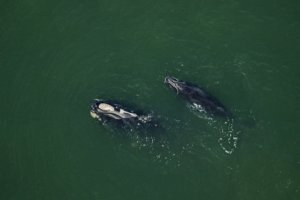
The North Atlantic right whale named “Minus One”, (catalog number 2430) photographed with her young calf on January 11, 2021 near Ponte Vedra Beach, Florida ©FWC under NOAA permit 20556-01
Casualties and Births
Since 2017, North Atlantic right whales have been experiencing what is known as an “exceptional mortality event”: the number of carcasses found each year is particularly high and seriously threatens the species’ survival. For this reason, the number of deaths, births and entanglements is being closely monitored.
Over the course of this event, authorities have identified 34 carcasses and 15 individuals seriously injured either by an entanglement or a collision and whose survival is uncertain.
(Figures updated November 23rd, 2021)
Mortalities
| Year | Mortalities in the US | Mortalities in Canada | Total |
| 2017 | 5 | 12 | 17 |
| 2018 | 3 | 0 | 3 |
| 2019 | 1 | 9 | 10 |
| 2020 | 2 | 0 | 2 |
| 2021 (en cours) | 2 | 0 | 2 |
| 13 | 21 | 34 |
D’après NOAA
Entanglements and severe injuries
The country indicated corresponds to the location where the entangled or injured animal was initially observed and may not be representative of the location where the incident occurred.
2017: 2 entanglements (1 in Canada, 1 in the US)
2018: 5 entanglements (2 in Canada, 3 in the US)
2019: 1 entanglement (Canada)
2020: 3 entanglements and 1 collision (US)
2021 (to date): 2 entanglements and 1 collision (US)
Births
| Season (winter of year…) | Number of calves tallied |
| 2009 | 39 |
| 2010 | 19 |
| 2011 | 22 |
| 2012 | 7 |
| 2013 | 20 |
| 2014 | 11 |
| 2015 | 17 |
| 2016 | 14 |
| 2017 | 5 |
| 2018 | 0 |
| 2019 | 7 |
| 2020 | 10 |
| 2021(en cours) | 17 |
Figures taken from the North Atlantic Right Whale Consortium 2020 Annual Report Card. Pettis, H.M., Pace, R.M. III, Hamilton, P.K. 2021.
Links and resources
Further reading on the species:
-North Atlantic right whale factsheet
Recognize individuals and discover their life stories:
North Atlantic right whale photo-identification catalogue
Where are the right whales right now?
Interactive North Atlantic right whale sightings map: WhaleMap and On alert for whales
Surveillance and prevention in Canada:
Discover the right whale monitoring and surveillance activities in Canada being carried out by Fisheries and Oceans Canada
Understand the 2021 fishery management measures to protect right whales put in place by Fisheries and Oceans Canada
Discover the collision prevention measures implemented by Transport Canada
Resources:
Summary of the exceptional mortality event (2017-2021 statistics) by NOAA Fisheries
View the details of the 2021 calving season compiled by NOAA Fisheries
North Atlantic Right Whale Consortium (NARWC) – Annual Report Card
2020 Annual Report By Anderson Cabot, Center for Ocean Life
Reports and documentaries:
Entangled (2020) – a film by David Abel and Andy Laub
Baleines noires (2017) – Documentary Découverte on Tou.Tv (in French)
Deep Trouble (2017) – 6-episode podcast produced by CBC
Social media:
New England Aquarium Right Whale Research Program (Facebook)
Center for Coastal Studies (Facebook)


